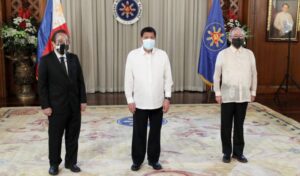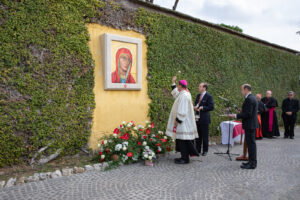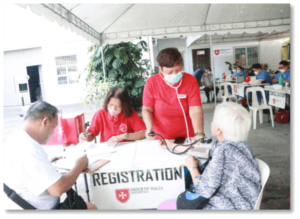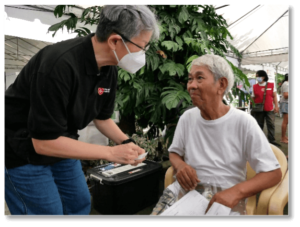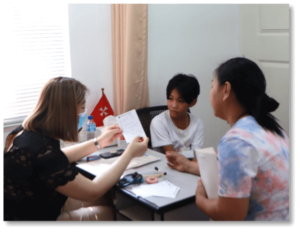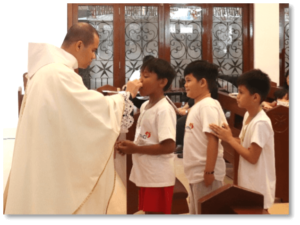The Hospitaller Trailblazers: Establishing the Sovereign Order of Malta in the Philippines
Performing their Hospitaller duties post-war as best they could, the Delegation, also called the Caballeros de Malta, were a major help, financing the large orphanage Hospicio de San Jose’s daily food and medical requirements and rebuilding the old Balala Hospital in Culion, Palawan. The leprosarium had had to end its operations when Japanese troops had taken over the island.
Inspired by the Spanish Delegation’s works of mercy, Filipinos were encouraged to form their own Order. Finally, in 1957, the Grand Magistry in Rome gave its blessing for the conversion of the Delegation into a national association: the Philippine Association of the Sovereign Military Order of Malta.
Sadly, Don Paulino Miranda de Sampedro had died the year before, having been a Delegate (his official title as the Delegation’s leader), until his death in 1956. Henceforth, Ambassador Manuel Morán took the helm as the Philippine Association’s first president.
Prior to serving as president of the Order, Manuel Morán could claim a long list of impressive positions. Among them, he had served as Chief Justice of the Philippine Supreme Court immediately after the war, from 1945 to 1951. Then he had been the first Philippine ambassador to Spain as well as to the Holy See, from 1951 to 1953. Morán was renowned as the Father of Philippine Remedial Law, having written several volumes on the subject.
Even before his tenure as Supreme Court Chief Justice and president of the Order, Morán’s strong sense of justice came to the fore in the 1938 Cuevo-Barredo case. After the lower court had decided to absolve defendant Fausto Barredo, plaintiff Silvestra Cuevo petitioned the Court of Appeals to review the ruling.
The case at bar: Carpenter Anastacio Lozano had drowned in the river when his foreman ordered him to retrieve a log carried away by the current during a strong typhoon. Initially, the court viewed the event merely as an accident, arguing that the defendant, as the job’s contractor, was not accountable for the carpenter’s drowning, since it was not due to a defect in their work condition.
But Morán, who was an Associate Justice of the Court of Appeals, saw the situation differently, saying that, “Bravery bordering on heroism should not be condemned but commended. If there is negligence at all, it is the negligence of the employer (who places) more value upon a piece of floating log than upon his employee’s life.”
In the landmark case, the Supreme Court upheld Moran’s opinion, which reversed the lower court’s judgment, concluding that the foreman had been negligent in not taking the necessary precautions to prevent his worker’s death.
Under Morán as president of the Order, negotiations with the Philippine government commenced during the incumbency of President Diosdado Macapagal. The Order sought to represent itself The Supreme Court of the Philippines not just as an organization, but as an actual embassy of the Sovereign Military Order of Malta, with the government recognizing the Hospitaller Order’s sovereignty and extraterritoriality. This status would allow the Order to elect ambassadors, as well as to be granted the diplomatic privileges given to embassies, as stipulated in the Order’s original charter handed down by the Pope in the 12th Century.
The Order’s diplomatic status would enable the Hospitallers to receive substantial aid in medicines and emergency goods from members and charitable organizations abroad exempt from paying Customs duties and taxes.
The ease by which the Order was granted an audience with the head of state was a testament to its Filipino members’ prominence, and the worthiness of their cause.
President Diosdado Macapagal lost his bid for presidential reelection in 1965 to Ferdinand Edralin Marcos, a lawyer. The new president’s election marked the start of what eventually would become a two decade-long dictatorship.
That same year, the Philippine Association elected three officers. Don Ernesto V. Lagdameo succeeded Don Manuel Morán as president. Resulting from the foundation laid out by Morán and former Philippine President Macapagal, negotiations for diplomatic relations were completed under President Marcos.
Forthwith, the ambassador of the Republic of the Philippines to the Holy See, Don Benigno Toda y Toledo, Sr., was named the Filipino Envoy Extraordinary and Minister Plenipotentiary to the Order of Malta in Rome, in July 1965, bringing the Order closer to its goal to establish an embassy.
A demonstration of Lagdameo’s efficiency as PASMOM president was evident in the case of Juan F. Nakpil, the son of Philippine Revolution veterans Julian Nakpil and Gregoria de Jesus (revolutionary Supremo Andres Bonifacio’s widow). Nakpil had trouble with his admittance to the Order.
Urged by his friend and former Delegate Paulino Miranda Sampedro, Nakpil had submitted his application to the Order in March 1950. He had never received confirmation of his membership status, and was pleasantly surprised four years later, when he got a letter from the Order, inviting him to join the pilgrimage to the Marian celebration in Rome, addressing him as, “Cav. Mag. del S.M.O. di Malta.”
Unfortunately, because he had misplaced certain necessary documents, the issue of his membership was overlooked for 17 years. Only when he found the missing papers in 1967, did Nakpil finally write a letter to the Order, to once and for all confirm whether or not he was a member. Lagdameo quickly responded and forwarded the letter to those more familiar with Nakpil’s case, as well as the proper procedure to be followed. The problem was solved immediately and Juan F. Nakpil was admitted to the Order that same year, 1967. He was named National Artist for Architecture in 1973.

Sovereign Military Hospitaller Order of St John of Jerusalem of Rhodes and of Malta
1120 R. Hidalgo Street, Manila, Philippines Tel. +287080860 | orderofmaltaphilippines@gmail.com
